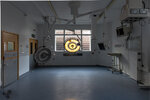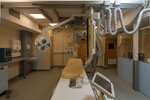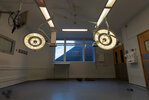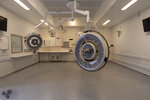Royal Papworth
This place was on our list since the construction began of the new building at Addenbrookes, Cambridge, and since that would leave a fully stocked specialist hospital closed nearby was a safe to say a visit was on the cards.
Let's have a look at the history.
The hospital's history began as an a experimental scheme as a colony for those suffering with Tuberculosis (TB for short) under Cambridgeshire's TB officer Dr Pendrill Varrier-Jones in the village of Bourn, 1916. Following the success of the patients and a donation of £5000 Dr Pendrill Varrier-Jones purchased Papworth Hall with plans to expand the estate to continue his scheme. Becoming known as the Cambridgeshire Tuberculosis Colony, initially 17 patients and 4 staff arrived at the building treating discharged soldiers from the ongoing war (WW1) where cases of Tuberculosis had risen dramatically in the battlefields. The continuing success of the hospital helped Dr Pendrill Varrier-Jones work on what he called the after care problem suggested giving patients fresh air and light work which made a common sight at Papworth hall for patients to be seen on the balconies of the building as well as outside the wooden huts built around site. The site later became known as the Papworth Village Settlement around 1929 with new hospital buildings starting to be developed a year or so later.
Following the second world war the NHS was formed and the colony became part of the NHS now known as the Papworth Hospital in 1948. Still operating as a TB hospital chest surgeons were attracted to the site, as some earlier treatments for TB involve operating on the lungs with varying degrees of success, with increasing surgical facilities it wasn't long until the hospital was branching into different regions of treatment. The hospitals interests turned towards thoracic (chest and lung) surgery in this time and later to cardiac surgery. Within a few years by 1958 surgeon Ben Milstein performed one of the first open heart surgeries at the hospital.
 (Image from an article, note the rather old Hanaulux lamp)
(Image from an article, note the rather old Hanaulux lamp)
Later in August 1973 surgeon Terence English performed the first successful heart transplant in the UK with the patients living for 5 years after.
Yet again in 1986 Papworth created history again performing the first ever Heart, Lung and Liver transplant within the same operation performed by surgeons John Wallwork and Roy Calne.
Papworth later became the hospital in which the worlds first battery operated heart to be implanted into a patient. The hospital's popularity and reputation was now well known with the hospital starting to grow further with Diana, princess of wales opening the Respiratory Support and Sleep Center in 1993 and later a specialised Cystic-Fibrosis centre from 1994.
May 2014 saw the unveiling of a new CT-Scanner by the Duchess of Gloucester the hospital's royal patreon.
Later in 2015 the hospital would make news again by performing Europe's first non-beating heart transplant from a confirmed to be circulatory dead donor, a break through as previous donor organs were only from those with still beating hearts after being diagnosed as brain dead.
2017 saw the hospital given the "Royal" designation by the queen later becoming Royal Papworth Hospital in 2018.
Eventually May 2019 saw the hospital's services depart for newer facilities in Cambridge.
(Sources: https://royalpapworth.nhs.uk/ and Wikipedia)
The Visit
Although I had many visits here I only managed to fully cover Three of the Four main buildings of interest onsite for this report.
Papworth Hall
We did this building shortly before the hospital's closure, which was amusing being watched by patients who we exercising along the duck pond.
The building was already empty with most of the admin being re located to the Biomedical campus already at Addenbrookes.
Looking from the main entrance towards the stairs.

A rather empty room with surviving details.

Pink!



The Christopher Parish Building
This was considered the "main" building on our visits. Housing the Operating Theatres, X-Ray, CT, Nuclear Medicine ect.
Theatres.
All of these rooms were equipped with ALM Maquet H LED surgery lights with some equipped with monitoring cameras.
Theatre 5


Theatre 4

I couldn't remember the number of these ones.




X-Ray
The department was rather extensive and I have missed one or two rooms by mistake. The X-rays mostly conducted angiograms and were here mostly for this purpose.




The CT scanner, sometimes confused for an MRI.



Beds, corridors and wards.





Next up was the Pathology building.
Mostly know for the morgue we headed there straight away but found over selves limited for time.

And that should be all.
I did make a revisit a few months later, and for those wondering about weather the equipment was left this should give you an idea.

Turns out there's a limit to the amount of photos to a report......
This place was on our list since the construction began of the new building at Addenbrookes, Cambridge, and since that would leave a fully stocked specialist hospital closed nearby was a safe to say a visit was on the cards.
Let's have a look at the history.
The hospital's history began as an a experimental scheme as a colony for those suffering with Tuberculosis (TB for short) under Cambridgeshire's TB officer Dr Pendrill Varrier-Jones in the village of Bourn, 1916. Following the success of the patients and a donation of £5000 Dr Pendrill Varrier-Jones purchased Papworth Hall with plans to expand the estate to continue his scheme. Becoming known as the Cambridgeshire Tuberculosis Colony, initially 17 patients and 4 staff arrived at the building treating discharged soldiers from the ongoing war (WW1) where cases of Tuberculosis had risen dramatically in the battlefields. The continuing success of the hospital helped Dr Pendrill Varrier-Jones work on what he called the after care problem suggested giving patients fresh air and light work which made a common sight at Papworth hall for patients to be seen on the balconies of the building as well as outside the wooden huts built around site. The site later became known as the Papworth Village Settlement around 1929 with new hospital buildings starting to be developed a year or so later.
Following the second world war the NHS was formed and the colony became part of the NHS now known as the Papworth Hospital in 1948. Still operating as a TB hospital chest surgeons were attracted to the site, as some earlier treatments for TB involve operating on the lungs with varying degrees of success, with increasing surgical facilities it wasn't long until the hospital was branching into different regions of treatment. The hospitals interests turned towards thoracic (chest and lung) surgery in this time and later to cardiac surgery. Within a few years by 1958 surgeon Ben Milstein performed one of the first open heart surgeries at the hospital.
Later in August 1973 surgeon Terence English performed the first successful heart transplant in the UK with the patients living for 5 years after.
Yet again in 1986 Papworth created history again performing the first ever Heart, Lung and Liver transplant within the same operation performed by surgeons John Wallwork and Roy Calne.
Papworth later became the hospital in which the worlds first battery operated heart to be implanted into a patient. The hospital's popularity and reputation was now well known with the hospital starting to grow further with Diana, princess of wales opening the Respiratory Support and Sleep Center in 1993 and later a specialised Cystic-Fibrosis centre from 1994.
May 2014 saw the unveiling of a new CT-Scanner by the Duchess of Gloucester the hospital's royal patreon.
Later in 2015 the hospital would make news again by performing Europe's first non-beating heart transplant from a confirmed to be circulatory dead donor, a break through as previous donor organs were only from those with still beating hearts after being diagnosed as brain dead.
2017 saw the hospital given the "Royal" designation by the queen later becoming Royal Papworth Hospital in 2018.
Eventually May 2019 saw the hospital's services depart for newer facilities in Cambridge.
(Sources: https://royalpapworth.nhs.uk/ and Wikipedia)
The Visit
Although I had many visits here I only managed to fully cover Three of the Four main buildings of interest onsite for this report.
Papworth Hall
We did this building shortly before the hospital's closure, which was amusing being watched by patients who we exercising along the duck pond.
The building was already empty with most of the admin being re located to the Biomedical campus already at Addenbrookes.
Looking from the main entrance towards the stairs.
A rather empty room with surviving details.
Pink!
The Christopher Parish Building
This was considered the "main" building on our visits. Housing the Operating Theatres, X-Ray, CT, Nuclear Medicine ect.
Theatres.
All of these rooms were equipped with ALM Maquet H LED surgery lights with some equipped with monitoring cameras.
Theatre 5
Theatre 4
I couldn't remember the number of these ones.
X-Ray
The department was rather extensive and I have missed one or two rooms by mistake. The X-rays mostly conducted angiograms and were here mostly for this purpose.
The CT scanner, sometimes confused for an MRI.
Beds, corridors and wards.
Next up was the Pathology building.
Mostly know for the morgue we headed there straight away but found over selves limited for time.
And that should be all.
I did make a revisit a few months later, and for those wondering about weather the equipment was left this should give you an idea.
Turns out there's a limit to the amount of photos to a report......
Attachments
Last edited:






